AKR in Oman 3.3: The Art of Bedouin Razfa — Salim Ali Kamis and Razfa Al Hamasiyyah
AKR in Oman Part 3
3.3: The Art of Bedouin Razfa — Salim Ali Kamis and Razfa Al Hamasiyyah
I have been moseying around the Salalah Tourism Festival for a week now. Events are transpiring faster than I can keep track of them as each day brings new acquaintances and often with them, invitations that spin off into sub-plots of their own. Let me describe then just one interesting person I met on the trail.
Salim Ali Kamis is the head of Razfa al-Hamasiyyah, a group from the Northern coastal city of Sohar, that perform the ancient Bedouin verbal art, Razfa. When I came upon the performance area, just a long rectangular carpet on a huge plaza and food court, the group had apparently just finished but I inquired about the group’s leader who was immediately identified to me. I started asking questions and told him a little about myself. We then exchanged numbers and everyone took a few photos. Salim and his companions explained that Razfa was an ancient Bedouin art dating back 2,000 years. All of the troupes members were from Bedouin tribes but their families were now settled city and town dwellers. They said they would be at the Salalah Festival for a few more days.
Figure 1: We took pictures of each other on the night of our first meeting. Note the signs for “Chick Hut” and “Crispy,” two popular fried chicken chains in the region. Salim Ali Kamis is pictured on the left.
When performed traditionally, two lines of men face each other and toss lines of poetry, that are “given to them” by the sha‘ir, or lead poet, back and forth. Various innovations in Razfa have occurred over the years, for example the addition of drums, then keyboard, and later pre-recorded sound tracks of both music and words. I had seen all of these variations in Razfa at the Muscat Festival in February.
Although Razfa is an art that celebrates machismo and victory after war, texts also can concern love and praise for people who have died or for heroes of the past. Some texts are “from our grandfathers,” others newly composed. Everything I saw and heard of Razfa was confirmed by the excellent documentary multimedia ethnography, a book by Dieter Christensen and Salwa El-Shawan Castelo-Branco, with the assistance of Omani musicologist Khalfan Barwani, titled Traditional Arts in Southern Arabia: Music and Society in Sohar, Sultanate of Oman (2009). This excellent work, which becomes more and more useful to me every day, is based on the collective fieldwork of the three co-authors conducted between 1985 and 1992 with re-visits to Sohar in 2004-2006, and includes companion CDs and DVDs of the performances they recorded.
While the great majority of performing arts here at the Salalah Festival are from Dhofar, I was curious about Razfa as the performing troupes in Muscat I saw seemed somewhat formidable to me. The guys in Razfa al-Hamasiyyah were so nice and I was dying to get a better sense of the art so I made it a priority to call and find them again for another performance.
I looked in the same place for Salim’s group the next day and the day after that. Then I called! Salim said they would be performing at the theater that evening but when I arrived they were finished and other troupes were performing. No problem he said, we’ll be here tomorrow too. As we chatted and watched another group who was performing with a CD, I asked Salim if he wrote poetry. “Of course,” he smiled “Qasa‘id,” and he said he could do it live and on the fly but that he also had many, many long poems that he had composed over the years. “Can you perform this way, in the traditional way?” I asked. “We will try tomorrow night,” he assured me.
The next night several Rafza groups, all of them from the Northern and Eastern regions of Oman, performed; all of them used a back up CD as their sound track. Some of the members mouthed the words, but clearly the role of the lead poet had changed – the sound track was completely canned with the keyboard synthesizer and drum track dominant. Rather than two lines facing one another, there was just one line of men who stood holding the arm of their neighbor with one hand and the thin, light cane or “camel stick” called ‘asa. The ‘asa has moved beyond the Bedouin environment and has become a mandatory accessory of formal male dress in Oman along with a belt and hanjar (dagger). If men are dressed this way in Muscat, they are either going to some sort of formal affair or, they are ministers (or close to them). Whether or not these men do anything with camels is beside the point. The ‘asa is to be held in a dignified fashion when seated or standing (but not to be leaned on too hard). It is the symbol that counts!
Figure 2: The light cane or camel stick is a popular item for sale to tourists and locals in the Nizwa market.
The men in the single line facing the audience toss their sticks up and down in unison – and usually in time to the music. One or two or three men, sometimes more, break away from the line and twirl their sticks over their heads, sometimes twirling themselves. And performers manipulate their sticks in other coded ways, the meanings of which are too nuanced for me to understand (at this point). One of the most distinctive aspects of the dance is the way the men jerk their neck, bobbing their heads in a way that emulates the undulations of the camel. They bend forward at the torso and hold this pose, bobbing their heads all the while, sometimes letting their sticks fall to the ground. Sometimes two or three solo dancers will come forward and kneel down, all the while bobbing their heads like the camels whose aesthetic and economic value in Omani Bedouin culture is paramount.
Figure 3: Two members of Razfa al-Hamasiyya danced up to me where I was sitting on the step at the back of the stage.
Figure 4: How many camels can you fit in a Toyota pickup? I met this pair in the town of Thumrait, north of Salalah, just over the mountain pass and back into the desert.
So last night I went to the festival hoping to hear Salim Ali Kamis deliver lines of poetry to his troupe “in the traditional way.” Alas this was just simply not meant to be. Even though there were mikes set up in front of the row of men. The sound guy put on the prerecorded music (and words) from a CD, definitively framing the performance. Salim indicated that they hoped to perform in the traditional way for me for five minutes before the loud music but, in spite of Salim’s gestures from the stage toward the sound man, it couldn’t happen. In this context the performance for and with the crowd was about the dance, not the poetry. In fact security guards held off enthusiastic young guys who wanted to get up on stage and dance too until the very last group was performed. I needed to meet the members of the Firqa Mirbat at another stage and so, resigning myself to things they way they were, I left before the performance was over.
Figure 5: Razfa Al Hamasiyyah performs at the Salalah Tourism Festival, 2011. The sound man is barely visible, next to the white chair, above the stage.
Then, just before I was ready to head home to the Hamdan Hotel, at about 11:45 p.m., Salim called. My Arabic is certainly not great but I think it is a little better than Salim’s English. There was no way I could understand what he was saying over the phone so I went back to the stage to meet him. “Look,” he said: “We will perform ‘live’ tomorrow in Ain Sahnawt, why don’t you come along?”
So this afternoon I met Salim and one of his troupe’s members, and off we went. We talked about many things as we headed into the green mountains above Salalah, including the art of Razfa, his job in the police force, camels, how to get to Ain Sahnawt (I had a map), and his car, a 1992 Mercedes Benz with almost 400,000 kilometers on the odometer!
“It’s a great car! I take good care of it. It is made in Germany!” Salim boasted, “Hitler!”
We all laughed.
Salim said that the Fann ir-Razfa, an art that is shared by the desert people of Oman and the United Arab Emirates, is as much about the recording as it is about the poetry. He explained what it takes to make a music video (video clip). 1,000 Omani Riyals for the studio time, the music, the chorus, the costumes and the shooting of four hours of footage for a 4.5 minute clip. Four and a half minutes is too short for a classic Qasidah, which, ideally, he told me includes 14 lines of poetry. Just eight lines are all you can include in a prerecorded song. As we drove through the misty mountains he recited one of his Qasa‘id, which he composed about 10 years ago: 14 lines, each made up of two halves (hemistich) with an internal rhyme of N (the Arabic letter nun) and a final rhyme of F (the Arabic letter fa). I played the recording back for him as we waited around for the live shooting by Oman television to begin. He was pleased and I promised to make him a copy to bring to him in Sohar.
Figure 6: Salim Ali Kamis in Ain Sahnawt, driving his beloved Mercedes while reciting one of his poems for me.
At the live shooting, the producers from Oman TV blasted a pre-recorded soundtrack from their car while they filmed the two troupes dancing Razfah on the slippery grass in the very un-Bedouin-like setting of the wet, green mountains of Dhofar. That’s the way it was done – which is not to say that is how it is always done.
So, I have yet to see Razfa al-Hamasiyyah perform “in the traditional way” but I have learned a lot about Razfa and am grateful for the opportunity to spend time with the generous and friendly members of Salim’s troupe. They are all headed back to Sohar in their caravan of cars and pickups this evening. Salim says they’ll drive the 1,000 kilometers straight through in about 10 hours. “That’s all?” I exclaimed.
“Sure,” Salim asserted. “I’ll drive 190 kilometers an hour. This car can go up to 220! I take good care of it! It is made in Germany! Hitler!”
We all laughed.
Figure 7: Razfa Al Turath (another group from Sohar) performs in the slippery grass for the live shooting by Oman Television.
AKR
NB. Tomorrow I am off to the town of Mirbat for the Festival Day of this special region. Thursday, I am invited to another wedding and in a few days, I’ll attend the second of three big pop concerts programmed as a part of the festival. Stay tuned.

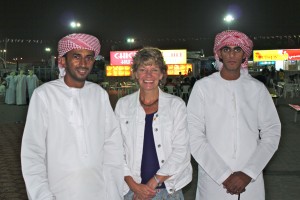
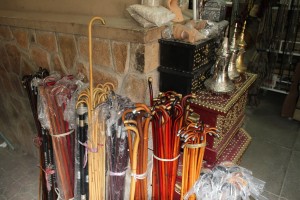
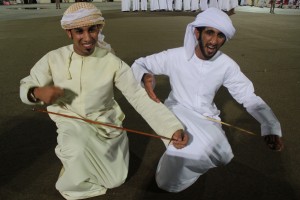
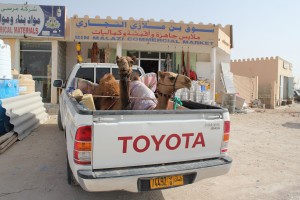
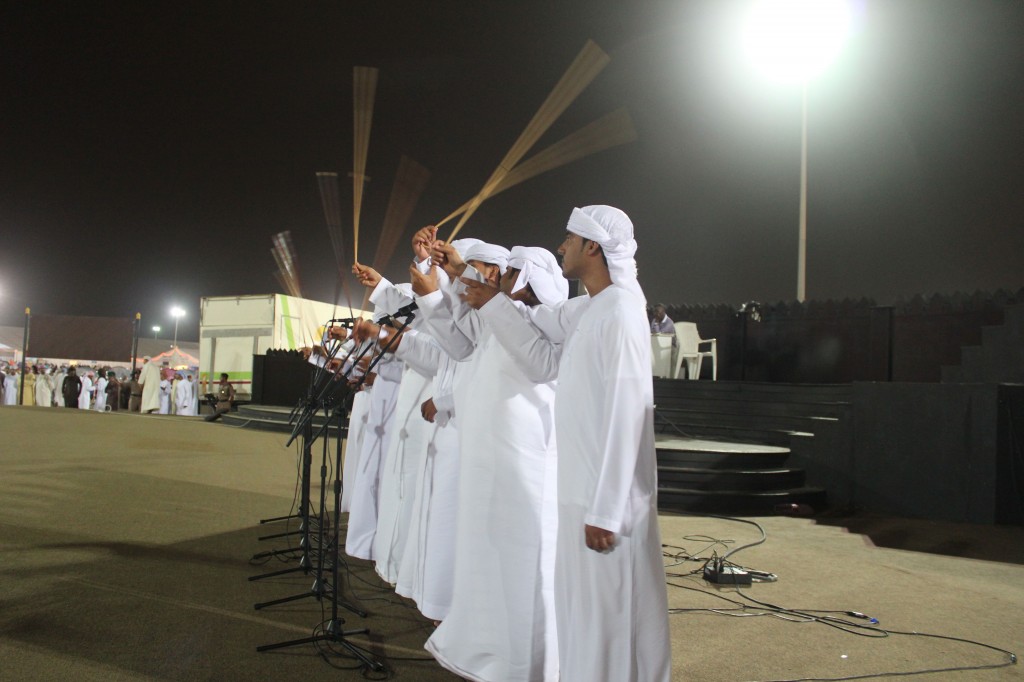
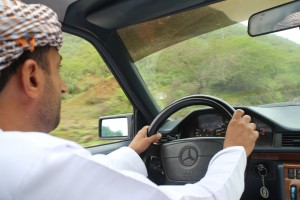
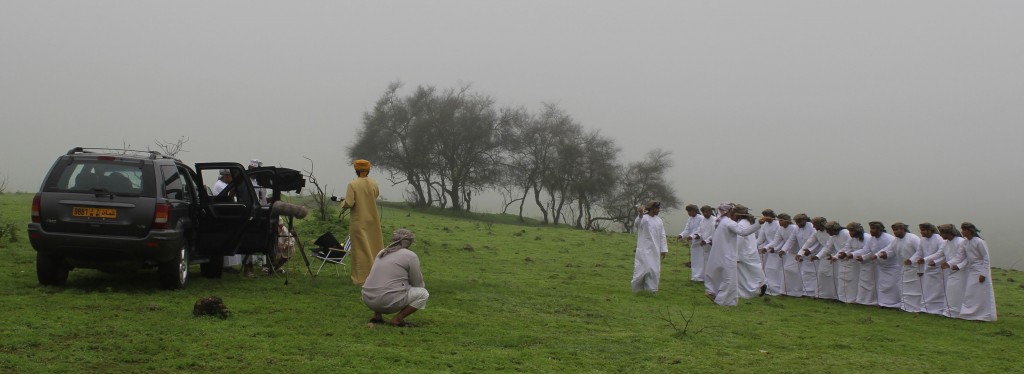


No comments.
Comments are currently closed. Comments are closed on all posts older than one year, and for those in our archive.